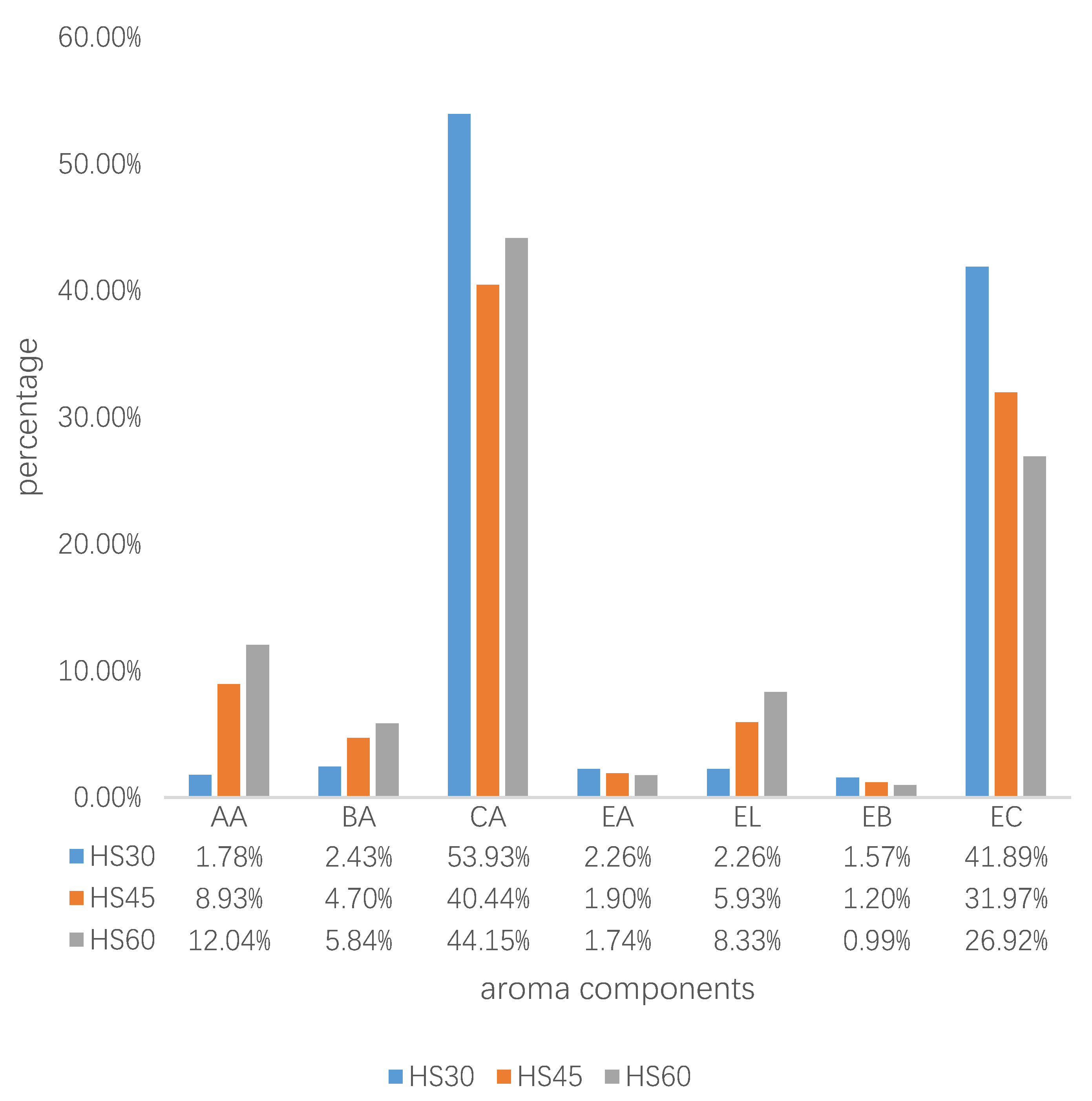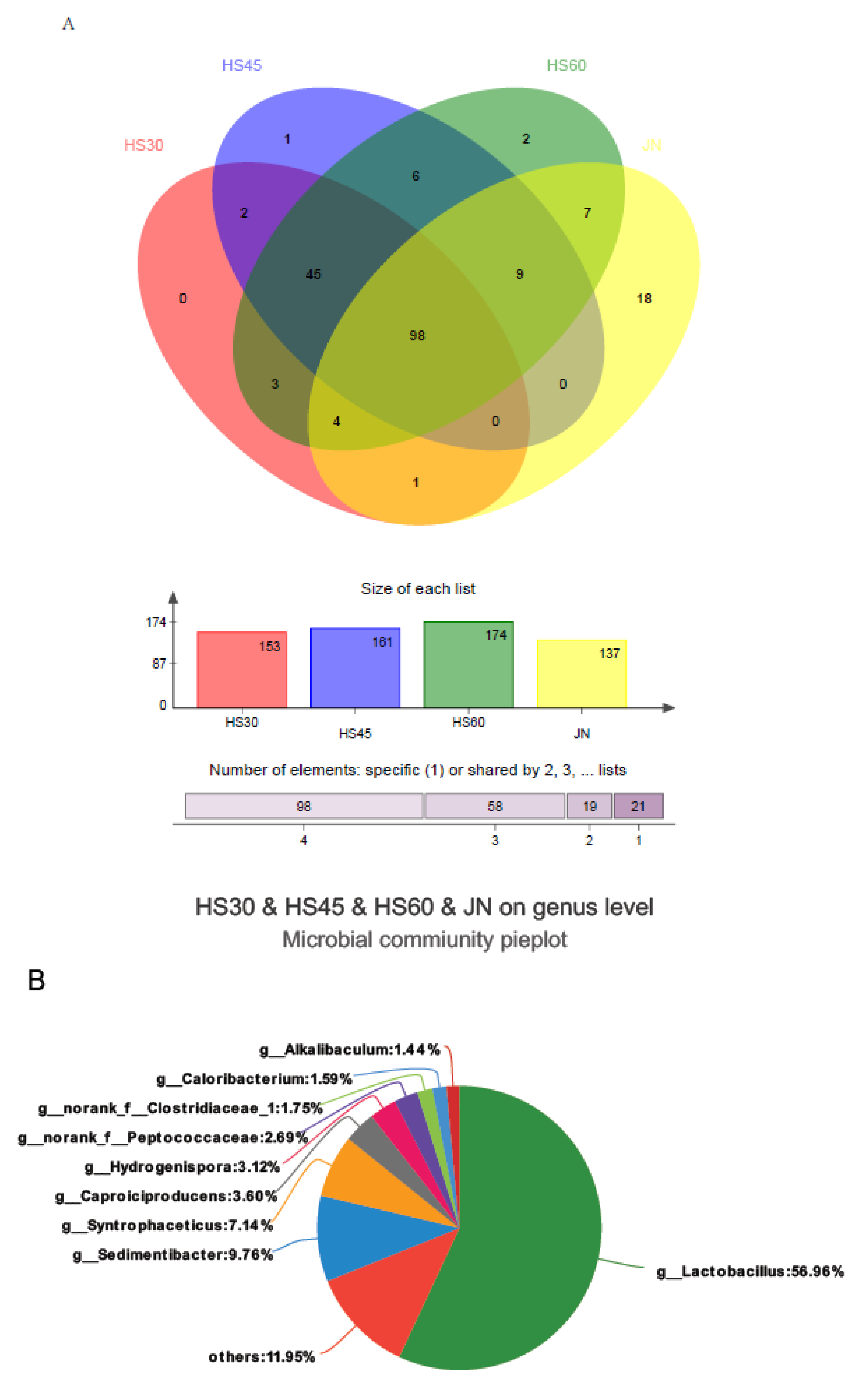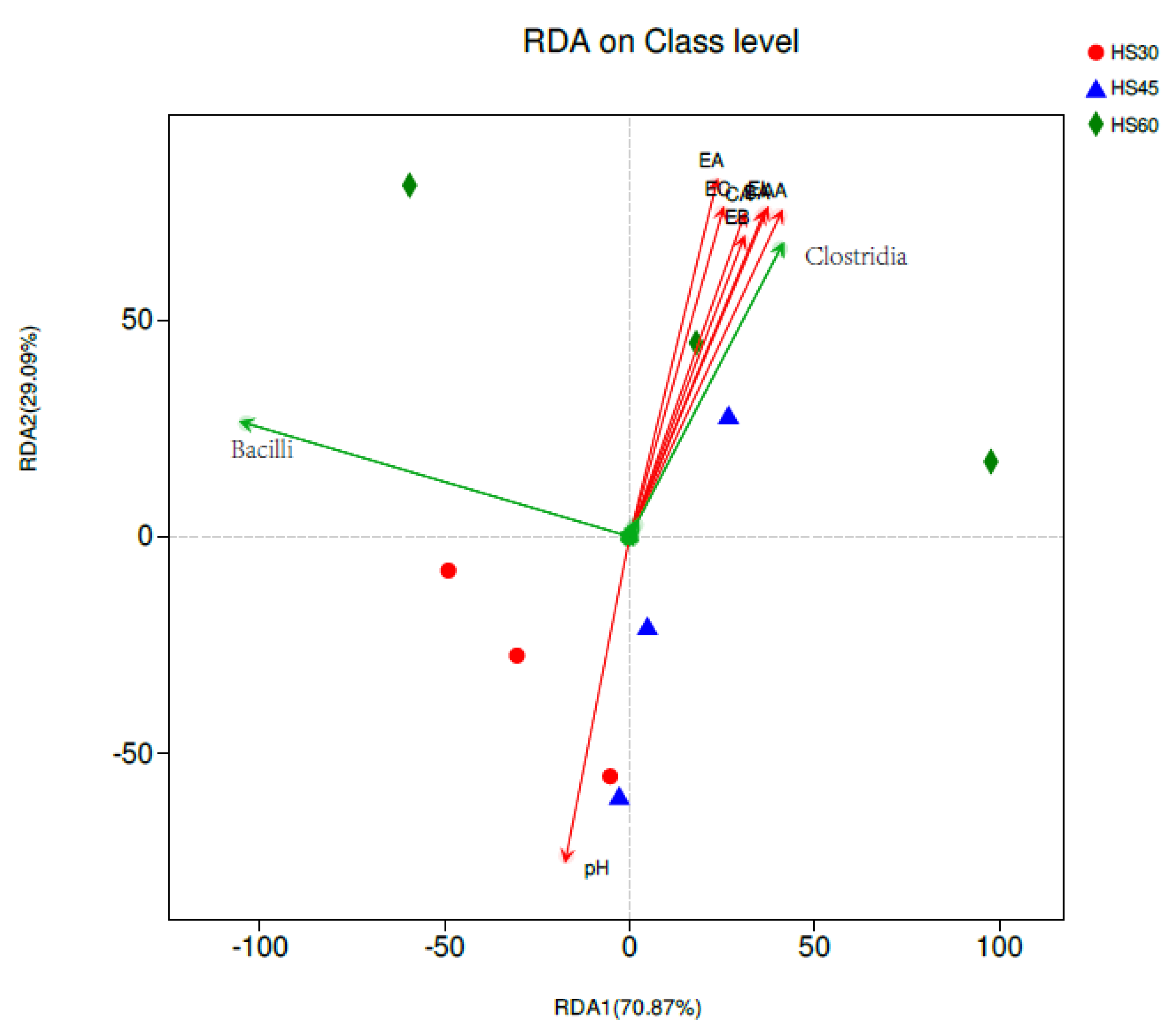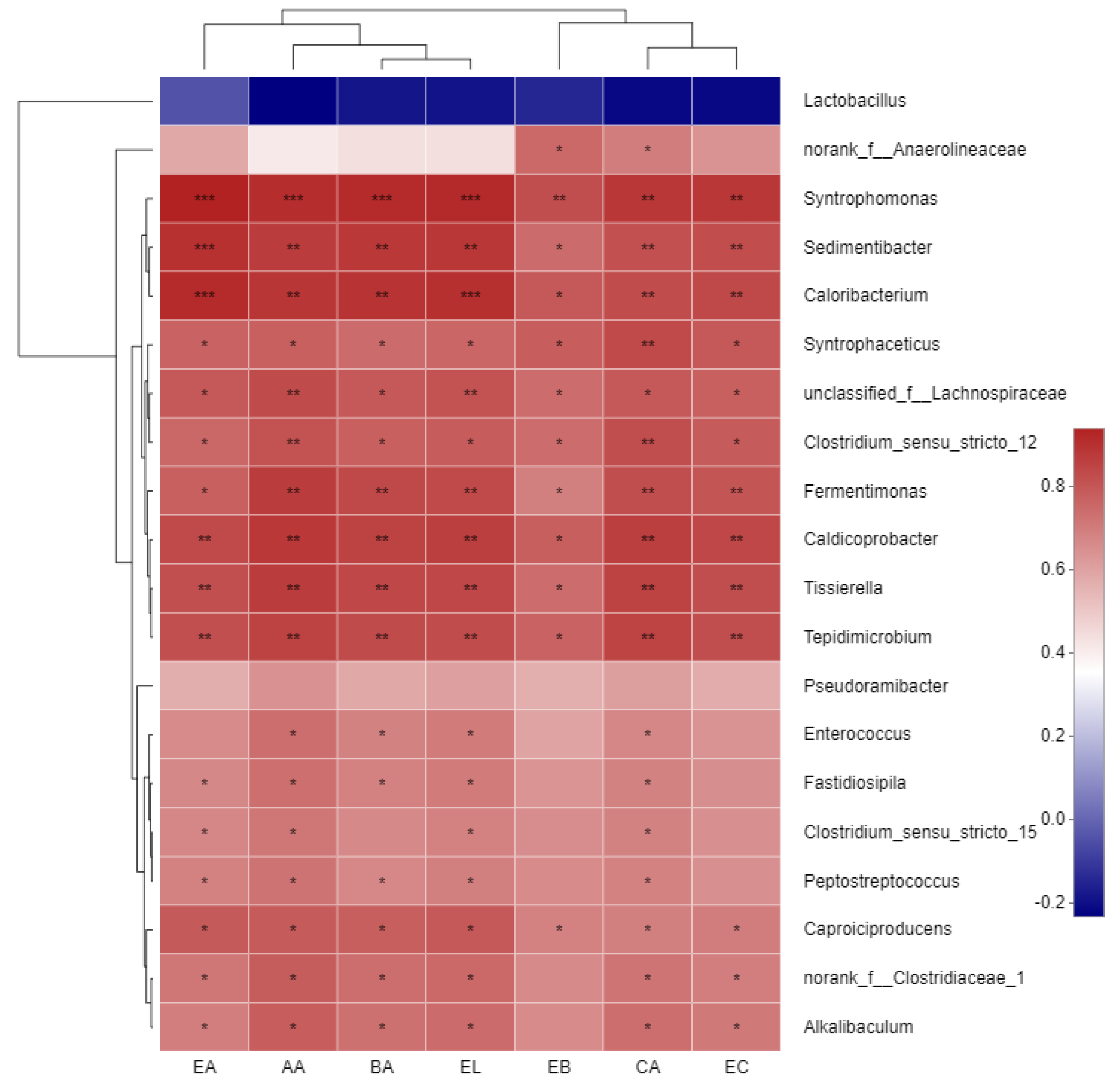Effect of Pit Mud on Bacterial Community and Aroma Components in Yellow Water and Their Changes during the Fermentation of Chinese Strong-Flavor Liquor
Abstract
1. Introduction
2. Materials and Methods
2.1. Sampling Method for Yellow Water and Pit Mud
2.2. Determination of pH and Acidity of Yellow Water
2.3. Flavor Components of Yellow Water and Pit Mud
2.4. DNA Extraction of Yellow Water and Pit Mud
2.5. High-Throughput Sequencing Analysis
3. Results
3.1. pH and Acidity of Yellow Water
3.2. The Aroma Components of the Pit Mud and Yellow Water
3.3. Diversity of Bacterial Community in Yellow Water and Pit Mud
3.4. Changes of Bacterial Community
3.5. Relationship between Bacterial Community and Aroma Components of Yellow Water
4. Discussion
5. Conclusions
Supplementary Materials
Author Contributions
Funding
Acknowledgments
Conflicts of Interest
References
- Xu, Y.Q.; Sun, B.G.; Fan, G.S.; Teng, C.; Xiong, K.; Zhu, Y.P.; Li, J.L.; Li, X.T. The brewing process and microbial diversity of strong flavor Chinese spirits: A review. J. Inst. Brew. 2017, 123, 5–12. [Google Scholar] [CrossRef]
- Tao, Y.; Wang, X.; Li, X.Z.; Wei, N.; Jin, H.; Xu, Z.C.; Tang, Q.L.; Zhu, X.Y. The functional potential and active populations of the pit mud microbiome for the production of Chinese strong-flavor liquor. Microb. Biotechnol. 2017, 10, 603–1615. [Google Scholar] [CrossRef] [PubMed]
- Li, D.H.; Li, G.H. The Key Factors of Chinese Strong Aromatic Spirits Brewing (Part 5). Food Ferment. Technol. 2011, 47, 32–41. [Google Scholar]
- Sun, Z.X.; Wang, J.K.; Ding, F.; Cui, B.Y.; Wang, J.; Sun, G.L.; Xiao, C. Approaches to Improve the Quality of Luzhou-flavor Daqu Liquor-Double Bottom Fermentation of Reflux Liquor. Liquor Mak. Sci. Technol. 2012, 218, 65–67. [Google Scholar]
- Zhou, X.H.; Cheng, X.; Yang, Y.; Luo, H.B.; Huang, Z.G. Study on the Change Rules of Parameters of Luzhou-flavor Liquor in Pits and Their Correlations (I): Physical and Chemical Parameter. Liquor Mak. Sci. Technol. 2012, 214, 39–43. [Google Scholar]
- Li, K.; Fan, Z.; Wang, J.; Lin, K.; Xiang, W. Microbial diversity in fermented yellow water of traditional intense flavor liquor. J. Food Sci. Biotechnol. 2015, 34, 1155–1161. [Google Scholar]
- Zhang, H.M.; Meng, Y.J.; Wang, Y.L.; Zhou, Q.W.; Anjun Li, A.J.; Liu, G.Y.; Li, J.X.; Xing, X.H. Prokaryotic communities in multidimensional bottom-pit-mud from old and young pits used for the production of Chinese Strong-Flavor Baijiu. Food Chem. 2020, 312, 126084. [Google Scholar] [CrossRef]
- Tan, G.X.; Hu, Y.L.; Huang, Y.N.; Liu, H.M.; Dong, W.W.; Li, J.; Liu, J.F.; Nan Peng, N.; Liang, Y.X.; Zhao, S.M. Analysis of bacterial communities in pit mud from Zhijiang Baijiu distillery using denaturing gradient gel electrophoresis and high troughput sequencing. J. Inst. Brew. 2020, 126, 90–97. [Google Scholar] [CrossRef]
- Hu, X.L.; Du, H.; Ren, C.; Xu, Y. Illuminating anaerobic microbial community and cooccurrence patterns across a quality gradient in Chinese liquor fermentation pit muds. Appl. Environ. Microbiol. 2016, 82, 2506–2515. [Google Scholar] [CrossRef]
- Stratford, J.P.; Beecroft, N.J.; Slade, R.C.; Gruning, A.; Avignone-Rossa, C. Anodic microbial community diversity as a predictor of the power output of microbial fuel cells. Bioresour. Technol. 2014, 156, 84–91. [Google Scholar] [CrossRef]
- Chao, A. Non-parametric estimation of the number of classes in a population. Scand. J. Stat. 1984, 11, 265–270. [Google Scholar]
- Jin, G.Y.; Zhu, Y.; Xu, Y. Mystery behind Chinese liquor fermentation. Trends Food Sci. Technol. 2017, 63, 18–27. [Google Scholar] [CrossRef]
- Zheng, X.W.; Han, B.Z. Baijiu, Chinese liquor: History, classification and manufacture. J. Ethn. Foods 2016, 3, 19–25. [Google Scholar] [CrossRef]
- Song, X.B.; Si, J.; Zhu, L.; Ma, C.F.; Song, T.; Wu, J.H.; Zhao, Q.Z.; Zheng, F.P.; Zhao, M.M.; Chen, F. Untargeted and targeted metabolomics strategy for the classification of strong aroma-type baijiu (liquor) according to geographical origin using comprehensive two-dimensional gas chromatography-time-of-flight mass spectrometry. Food Chem. 2020, 314, 126098. [Google Scholar] [CrossRef]
- Tan, G.X.; Li, J. Analysis of the compositions of yellow water & research advance in its application. Liquor Mak. Sci. Technol. 2010, 196, 90–92. [Google Scholar]
- Xie, X.; Huang, Y.J.; Hong, S.; Chen, M.; Wang, Y.Q. Study on the Regularity of Yellow Water and Its Influence to the Fermented Grains. Liquor Mak. 2017, 46, 20–23. [Google Scholar]
- Zhao, D.R.; Shi, D.M.; Sun, J.Y.; Li, A.J.; Sun, B.G.; Zhao, M.M.; Chen, F.; Sun, X.T.; Li, H.H.; Huang, M.Q.; et al. Characterization of key aroma compounds in Gujinggong Chinese Baijiu by gas chromatography-olfactometry, quantitative measurements, and sensory evaluation. Food Res. Int. 2018, 105, 616–627. [Google Scholar] [CrossRef]
- Fan, W.L.; Qian, M.Q. Characterization of aroma compounds of Chinese “Wuliangye” and “Jiannanchun” liquors by aroma extract dilution analysis. J. Agric. Food Chem. 2006, 54, 2695–2704. [Google Scholar] [CrossRef]
- Tao, Y.; Li, J.B.; Rui, J.P.; Xu, Z.C.; Zhou, Y.; Hu, X.H.; Wang, X.; Liu, M.H.; Li, D.P.; Li, X.Z. Prokaryotic communities in pit mud from different-aged cellars used for the production of Chinese strong-flavored liquor. Appl. Environ. Microbiol. 2014, 80, 2254–2260. [Google Scholar] [CrossRef]
- Sheng, J.; Xu, Y.C.; Ji, H.Y.; Liu, A.J. Analysis of organic components of yellow water from liquor fermentation. Sci. Tech. Food Ind. 2017, 38, 231–235. [Google Scholar]
- Zuo, F.; Liu, G.Y.; Li, A.J.; He, H.K.; Wang, L. Qunlitative analysis of flavor in pit muds during the solid-state fermentation process of Baijiu. Liquor Mak. 2018, 2, 45–48. [Google Scholar]
- Sun, X.B.; Wang, S.T.; Lu, Z.M.; Ao, Z.H.; Shen, C.H.; Shi, J.S.; Xu, Z.H. Determination and analysis of volatile compounds in Luzhou-flavor Daqu liquor pit mud. Food Mach. 2013, 6, 54–58. [Google Scholar]
- Sun, B.G.; Wu, J.H.; Huang, M.Q.; Sun, J.Y.; Zheng, F.P. Recent Advances of Flavor Chemistry in Chinese Liquor Spirits (Baijiu). J. Chin. Inst. Food Sci. Technol. 2015, 15, 1–8. [Google Scholar]
- Cavalcante, W.D.; Leitao, R.C.; Tito, A.; Gehring Largus, T. Angenent; Sandra Tedde Santaella. Anaerobic fermentation for n-caproic acid production: A review. Process. Biochem. 2017, 54, 106–119. [Google Scholar] [CrossRef]
- Spirito, C.M.; Richter, H.; Rabaey, K.; Stams, A.J.; Angenent, L.T. Chain elongation in anaerobic reactor microbiomes to recover resources from waste. Curr. Opin. Biotech. 2014, 27, 115–122. [Google Scholar] [CrossRef]
- Seedorf, H.; Fricke, W.F.; Veith, B.; Bruggemann, H.; Liesegang, H.; Strittmatter, A. The genome of clostridium kluyveri, a strict anaerobe with unique metabolic features. Proc. Natl. Acad. Sci. USA 2008, 105, 2128–2133. [Google Scholar] [CrossRef]
- Zhang, Y.Y.; Zhu, X.Y.; Li, X.Z.; Jia, J.; He, X.H. The process-related dynamics of microbial community during a simulated fermentation of Chinese strong-flavored liquor. BMC Microbiol. 2017, 17, 196. [Google Scholar] [CrossRef]
- Zou, W.; Zhao, C.Q.; Luo, H.B. Diversity and function of microbial community in Chinese strong-flavor Baijiu ecosystem: A Review. Front. Microbiol. 2018, 9, 1–15. [Google Scholar] [CrossRef]
- Hu, X.L.; Du, H.; Xu, Y. Identification and quantification of the caproic acid-producing bacterium Clostridium kluyveri in the fermentation of pit mud used for Chinese strong-aroma type liquor production. Int. J. Food Microbiol. 2015, 214, 116–122. [Google Scholar] [CrossRef]
- Tao, Y.; Zhu, X.Y.; Wang, H.; Wang, Y.; Li, X.Z.; Jin, H.; Rui, J.P. Complete genome sequence of Ruminococcaceae bacterium CPB6: A newly isolated culture forefficient n-caproic acid production from lactate. J. Biotechnol. 2017, 259, 91–94. [Google Scholar] [CrossRef]
- Breitenstein, A.; Wiegel, J.; Haertig, C.; Weiss, N.; Andreesen, J.R.; Lechner, U. Reclassification of clostridium hydroxybenzoicum as sedimentibacter hydroxybenzoicus gen. nov., comb. nov., and description of sedimentibacter saalensis sp. nov. Int. J. Syst. Evol. Microbiol. 2002, 52, 801–807. [Google Scholar] [PubMed]
- Guo, Z.; Ge, D.Y.; Shang, X.J.; Liu, W.H.; Yang, S.Y.; Zhang, Z.D. Comparative analysis on the diversity of bacterial microflora in degenerated and normal pit mud. Sci. Technol. Food Ind. 2018, 22, 93–98. [Google Scholar]
- Allen, T.D.; Caldwell, M.E.; Lawson, P.A.; Huhnke, R.L.; Tanner, R.S. Alkalibaculum bacchi gen. nov., sp. nov., a CO-oxidizing, ethanol-producing acetogen isolated from livestock-impacted soil. Int. J. Syst. Evol. Microbiol. 2010, 60, 2483–2489. [Google Scholar] [CrossRef]
- Hatamoto, M.; Imachi, H.; Fukayo, S.; Ohashi, A.; Harada, H. Syntrophomonas palmitatica sp. nov, an anaerobic, syntrophic, long-chain fatty-acid-oxidizing bacterium isolated from methanogenic sludge. Int. J. Syst. Evol. Microbiol. 2007, 57, 2137–2142. [Google Scholar] [CrossRef] [PubMed]
- Westerholm, M.; Roos, S.; Schnürer, A. Syntrophaceticus schinkii gen. nov. sp. nov., an anaerobic, syntrophic acetate-oxidizing bacterium isolated from a mesophilic anaerobic filter. FEMS Microbiol. Lett. 2010, 309, 100–104. [Google Scholar] [CrossRef]





| Sample | Sequence Number | Shannon | Chao1 |
|---|---|---|---|
| HS30 | 35918.33 ± 4036.73 | 1.31 ± 0.05 | 362.81 ± 23.10 |
| HS45 | 35285.67 ± 4621.46 | 1.87 ± 0.72 | 371.99 ± 37.31 |
| HS60 | 42233.67 ± 8418.46 | 2.58 ± 0.35 | 418.72 ± 35.66 |
| JN | 45635 ± 5843.77 | 2.86 ± 0.24 | 294.78 ± 31.33 |
© 2020 by the authors. Licensee MDPI, Basel, Switzerland. This article is an open access article distributed under the terms and conditions of the Creative Commons Attribution (CC BY) license (http://creativecommons.org/licenses/by/4.0/).
Share and Cite
Gao, Z.; Wu, Z.; Zhang, W. Effect of Pit Mud on Bacterial Community and Aroma Components in Yellow Water and Their Changes during the Fermentation of Chinese Strong-Flavor Liquor. Foods 2020, 9, 372. https://doi.org/10.3390/foods9030372
Gao Z, Wu Z, Zhang W. Effect of Pit Mud on Bacterial Community and Aroma Components in Yellow Water and Their Changes during the Fermentation of Chinese Strong-Flavor Liquor. Foods. 2020; 9(3):372. https://doi.org/10.3390/foods9030372
Chicago/Turabian StyleGao, Zhanzheng, Zhengyun Wu, and Wenxue Zhang. 2020. "Effect of Pit Mud on Bacterial Community and Aroma Components in Yellow Water and Their Changes during the Fermentation of Chinese Strong-Flavor Liquor" Foods 9, no. 3: 372. https://doi.org/10.3390/foods9030372
APA StyleGao, Z., Wu, Z., & Zhang, W. (2020). Effect of Pit Mud on Bacterial Community and Aroma Components in Yellow Water and Their Changes during the Fermentation of Chinese Strong-Flavor Liquor. Foods, 9(3), 372. https://doi.org/10.3390/foods9030372




